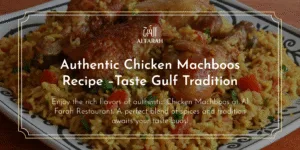Widely known as Mandi, the dish has its origins in Arabian and Yemeni culture and goes way beyond filling one’s stomach. It emanates from the Middle East and generally forms part of people’s main dishes for special events. Closely associated with Yemen, and its traditional spiced meat and rice dish, the treasure known as ‘Mandi’ has found favour with food enthusiasts across continents.
Origins
Mandi has its roots in the Hadhramaut region in Yemen. Historically, it was a food that the nomadic tribes used in preparation of a meal when they were in the wild doing hunting and gathering activities. Finally, as trades increased and the network of markets developed, clients from the Arabian Peninsula began to get acquainted with it, though today it is also essential in countries like Saudi Arabia, the Emirates and Oman.
Key Ingredients
The true essence of Mandi is therefore anchored to its basic, yet tasty ingredients. Basmati rice is most commonly used for this part of the dish; it is a type of long-grain rice that has a unique aroma and texture when cooked. The most common meat is mutton or chicken while fish especially in the coastal recipes is occasionally used. There is nothing like the spicing of this dish; the liberal use of cumin, coriander, cardamom, cloves, and saffron gives the dish warmth and a great aroma.
Preparation
Mandi in its authentic version is baked in an underground oven known as a tandoor. The spices for the grill are rubbed on the meat, and the meat is grilled over a wood fire; the slow process of cooking makes the juices penetrate through the meat and tenderize it. The rice is also cooked apart, usually in the drippings that are left after roasting the meat, to absorb the flavors. Today, variants may employ roast ovens or pressure cookers, yet the traditional way of preparing Mandi is by doing it slowly on low heat, which is why the dish is tender and succulent.
Types
Mandi has slight differences depending on the type of meat it is prepared with. The most common are:
- Chicken Mandi: A variation, generally characterized by the fact that it cooks faster than the original.
- Lamb Mandi: The Original or Classic or the thick and rich kind which is the most widely used and preferred variety.
- Fish Mandi: A coastal variation of this dish that employs fish instead of the more conventional ingredients of lamb or chicken.
Mandi vs Other Middle Eastern Rice Dishes
Mandi is said to have similarities with other Middle Eastern rice dishes such as biryani, kabsa and maqluba. Although the two types of dishes have some similarities in their preparation, each has its peculiarities. For example, Biryani is heavier in terms of spices and preparation processes than other dishes, and Kabsa, another Arabian popular dish, has the meat and rice cooked together slightly making it heavier on spices.
Serving
Mandi is usually served on a large plate in the middle of the table flying during prepares or shares food from the plate. Thus, it is served together with a variety of salads, yogurt-based sauces and a spicy tomato-based sauce called sahawiq. The meal is eaten by hand by the Arabian tradition which enhances the social aspect as well as the cultural one.
Health Benefits
Mandi is not only tasty but is also healthy for one to consume. The dish contains protein from the meat and carbohydrates from the rice. These spices used in it are popular for their health benefits; cumin has digestive properties, cardamom has detoxification benefits, and saffron has antioxidant properties. As indicated above, it is prepared with minimal oil and can be a healthy meal provided the accompanying foods are balanced.
Mandi in Modern Cuisine
Nonetheless, today, it is no longer only a traditional dish, but it has become popular in the contemporary kitchen. It has become an exotic delicacy on restaurant menus across the globe, from street vendors in Dubai to steak houses in London. Chefs are also innovating on fusions; adding in elements from different cuisines but still keeping true to the core concept of Mandi.
Cultural Importance
Other than being a type of food in Arabia, Mandi signifies the culture of welcoming and togetherness in the region. It is normally prepared for festive occasions like weddings, Eid days, and other customary ceremonies. I later realized that sharing ‘Mandi’ is a symbol of hospitality which is why it is a very significant part of any special events, ceremonies or family reunion.
The Evolution
While all the main ideas are still conserved, Mandi has been altered in its development process. Other variations have developed throughout regions; each area uniquely modified the recipe. For instance, Saudi Arabian Khamis might contain a higher level of spices than the same recipe in the UAE where the emphasis might be made on the kind and quality of meat used. However, the different preparations retain the base of what Mandi originally was—a plain yet yummy dish.
Where to Find
If you want a typical Mandi, it is always easier to try the place in the Arabian territories. Yemen and Saudi Arabian Mandi can be seen as very popular, and while there are restaurants and other establishments that serve it, there are restaurants that provide traditional Yemeni and Saudi Arabian Mandi. Apart from the Middle East, restaurants that offer Mandi are available in areas with large Arab populations, such as London and New York.
Making Mandi at Home
Mandi is generally a slow-cooked dish that needs a lot of effort and skill to prepare, but those who want to try this at home can try this easy recipe. This is particularly the rice and the meat. The main tips are to use quality ingredients and ensure that the meat is seasoned correctly. The rice is then cooked with the meat juices to enhance the overall flavor of the dish as is the case with Mandi. Home cooks should also be patient as many recipes that go into making the dish may take a long to cook fully.
Food Tourism
Mandi has indeed emerged as a leading food tourist destination for anyone who would want to start their exploration of Arabian cuisine. Currently, many travel companies organize tours to countries like Yemen and Saudi Arabia where tourists will be able to taste Mandi in the places where it is cooked according to the traditional recipes. Social networks have also been instrumental in branding the Mandi, where food bloggers and opinion leaders posted their experiences and memorable places where they tried the traditional dish.
Mandi: A Culinary Tradition That Embodies Arabian Heritage and Hospitality
Mandi is not just a food, but a part of the Arabian legacy representing the essence of their cooking style and hearty welcome. Its longevity can be attributed to the fact that it is simple, uses quality ingredients, and is a social experience. With the constant increase of its popularity in various countries, Mandi is still considered a true reflection of Arabian cuisine.










